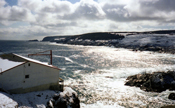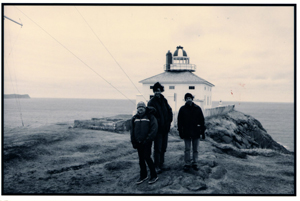La Raza Group at the Pouch
Cove Foundation
POUCH COVE RESIDENCY April 1-30, 2005
By G. Scott MacLeod
In
April 2005, La Raza Group was invited to the Pouch
Cove Foundation in Newfoundland. During this
four-week art residency, their aim was to create a
body of work for exhibition at the James Baird
Gallery by responding to the local people, landscape
and industry of St. John's, Newfoundland.
The Residency
During this residency we translated our first-hand
experiences boldly into a series of paintings,
drawings and a large collective mural. While
traveling around St. John’s and the Avalon Peninsula, we chronicled
our experiences with a camera and sketchbooks to use
later in the studio as reference material. Our large
mural was on a 2’ X 30’ piece of Mylar. In addition
to painting the people and places of Newfoundland,
we wrote down daily journal entries. 
Thanks to our tour guide-press
agent-cook-driver-source-of-inspiration Lori Butler
(or known as Red Leader for her beautiful
hair), we were able to have access to the people and
places of St. John’s and around the Avalon
Peninsula. As a result, we met
printmakers, musicians, poets, fisherman, postal
workers, inn keepers, veterans, school teachers, and
people from all walks of Newfoundland life, with the
intention of involving them in our process of
discovering the island. We had people pose for
photos and drawings and in the process we hoped to
have them relate their personal stories, oral
histories and local lore.
What is Newfoundland?
In my experience, most Canadians know little of
their country and in particular they know less about
“The Rock” (Newfoundland). I include myself in this
observation, but as an artist and musician it has
been my desire “to know” and understand our people,
history and country. Therefore these adventures
propel me to read, travel, experience and learn from
our native history and the construct called Canada.
Alas, Newfoundland is another place to discover!
Pouch Cove Foundation
The Pouch Cove Foundation and residency was
brought to my attention thanks to colleague Sophie Jodoin,
another painter who attended the residency a few
summers ago. Sophie introduced me to Mr. “It’s all
jigs and reels” James Baird owner and operator of
the Foundation. After my singular invitation I
realized that I should extend the invitation to my
art collective La Raza Group, as it would be a good
opportunity for a collective project as we have
previously done in Mexico City, Banff, Dublin,
Cologne, Detroit, and Honduras. As a result of our
experience in Newfoundland, La Raza produced a mural
with kids from St-Francis Elementary as a community
project, we are inclined to such outreach work as it
is the one of our group missions to do outreach in
the communities we visit. |
|
The
Cove
Pouch Cove is one of the most eastern villages in
Newfoundland and its claim to fame is the place
‘first to see the sun in Canada’. I saw this sign
every morning above the library/community
centre/day-care/fire department/town hall building
when I went to do my email. This should give one a
sense of how tight these seaside cove communities
are.
Island People
Having family roots in Cape Breton I have been
sensitive to island culture and the delicate balance
that must exist to preserve the people, villages,
industry and landscape of the island. In the 1950’s
my father, like many Cape Bretoners' before him, left
for better opportunities on the mainland. During my
stay in Newfoundland I soon discovered that many
Newfoundlanders shared the same experience, as many
leave their island to seek work opportunities
elsewhere as the island can support only a few. I
was told by our
guide-chef-driver-publicist-pub-crawl specialist
Lori Butler (as a side note, there are many
multi-talented people like Lori on the island) that
many do return from the big cities on the mainland
with the means to buy a home and stay on. Yet,
inevitably some do leave permanently, and their
"island ways" become memory and family history in
song and story. 
It
is interesting to note that Francis is from Ireland,
an island, Gerald’s father was from England, my
father was from the island of Cape Breton and Lori’s
forefathers come the island of Newfoundland. This
is something we all had in common, a shared history
and lineage to people who left their respective
islands in Scotland, Ireland and England either into
exile or simply for work opportunities that would
offer a better way of life. It seems that the
islands of our cultural landscapes are not that far
away; thus, through our work at this residency we
looked for the voices of our respective ancestors to
reclaim this heritage.
Thank
you Newfoundland!
We wish to thank all the lovely people of
Newfoundland who made this experience as memorable
as it was. Special thanks to the people of Pouch
Cove, Lori Butler a.k.a. (Red Leader) and family for
Newfoundland delights and the tour de l’ile, The
Elliot family, Loretta Decker and Brigitta Wallace
from Parks Canada, the custodians of the L’Anse aux
Meadows site, Claire-Marie Gosse from The
Independent, Craig Welsh from The Express, Angela
Antle from CBC St.John’s, David Marshak and family,
Martha Eleen, John Maggio, Linda from the Quidi Vidi
Inn, people from The Duke, Leo and the Folks at the
Crow’s Nest, Cape St-Francis Elementary School, Mr.
& Mrs. Redpath, Angie and Jim Baird, Mary for the
wonderful tour of Bell island, David Bolduc for his
Volvo service, Norma Nixon, Maurene White, Sophie
Jodoin, Jan Lundgren, Canadian Scandinavian
Foundation, Sean Cahill and Noelle Harris.

|
